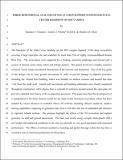| dc.contributor.author | Olsen, Matthew B. | |
| dc.contributor.author | Orazalin, Zhandos | |
| dc.contributor.author | Whittle, Andrew | |
| dc.date.accessioned | 2016-05-03T14:39:36Z | |
| dc.date.available | 2016-05-03T14:39:36Z | |
| dc.date.issued | 2015-04 | |
| dc.date.submitted | 2014-02 | |
| dc.identifier.issn | 1090-0241 | |
| dc.identifier.issn | 1943-5606 | |
| dc.identifier.uri | http://hdl.handle.net/1721.1/102384 | |
| dc.description.abstract | The basement of the Stata Center building on the MIT campus required 12.8 m deep excavations covering a large open-plan site and underlain by more than 25 m of lightly overconsolidated Boston Blue Clay. The excavations were supported by a floating, perimeter diaphragm and braced with a system of internal corner struts, rakers, and tieback anchors. The project involved a complex sequence of berms, access ramps, and phased construction of the concrete mat foundation. One of the key goals of the design was to limit ground movements in order to prevent damage to adjacent structures, including the Alumni Pool building, which was founded on shallow caissons and located less than 1.5 m from the south wall. Lateral wall movements and building settlements were closely monitored throughout construction, while photos from a network of webcams located around the open-plan site provide a detailed time history of the construction processes. This paper describes the development of a comprehensive three-dimensional (3D) finite-element (FE) model for the Stata Center basement excavation, which has been enabled by recent advances made available in a FE software package, including efficient multicore iterative solving capabilities, importing of geometric data from computer-aided design files, and use of embedded pile elements to represent tieback anchors. The analyses highlight the effects of the 3D excavation and support geometry on wall and ground movements. The base case results using a simple elasto-plastic Mohr–Coulomb soil model with undrained conditions in the clay are generally in very good agreement with measured performance. The effects of refined constitutive modeling and partial drainage within the clay have a secondary role in numerical predictions for this project. | en_US |
| dc.description.sponsorship | Republic of Kazakhstan (Bolashak Scholarship) | en_US |
| dc.language.iso | en_US | |
| dc.publisher | American Society of Civil Engineers (ASCE) | en_US |
| dc.relation.isversionof | http://dx.doi.org/10.1061/(ASCE)GT.1943-5606.0001326 | en_US |
| dc.rights | Creative Commons Attribution-Noncommercial-Share Alike | en_US |
| dc.rights.uri | http://creativecommons.org/licenses/by-nc-sa/4.0/ | en_US |
| dc.source | Prof. Whittle via Anne Graham | en_US |
| dc.title | Three-Dimensional Analyses of Excavation Support System for the Stata Center Basement on the MIT Campus | en_US |
| dc.type | Article | en_US |
| dc.identifier.citation | Orazalin, Zhandos Y., Andrew J. Whittle, and Matthew B. Olsen. “Three-Dimensional Analyses of Excavation Support System for the Stata Center Basement on the MIT Campus.” Journal of Geotechnical and Geoenvironmental Engineering 141, no. 7 (July 2015): 05015001. | en_US |
| dc.contributor.department | Massachusetts Institute of Technology. Department of Civil and Environmental Engineering | en_US |
| dc.contributor.approver | Whittle, Andrew | en_US |
| dc.contributor.mitauthor | Orazalin, Zhandos | en_US |
| dc.contributor.mitauthor | Whittle, Andrew | en_US |
| dc.relation.journal | Journal of Geotechnical and Geoenvironmental Engineering | en_US |
| dc.eprint.version | Author's final manuscript | en_US |
| dc.type.uri | http://purl.org/eprint/type/JournalArticle | en_US |
| eprint.status | http://purl.org/eprint/status/PeerReviewed | en_US |
| dspace.orderedauthors | Orazalin, Zhandos Y.; Whittle, Andrew J.; Olsen, Matthew B. | en_US |
| dc.identifier.orcid | https://orcid.org/0000-0001-5358-4140 | |
| dc.identifier.orcid | https://orcid.org/0000-0001-6348-1006 | |
| mit.license | OPEN_ACCESS_POLICY | en_US |
